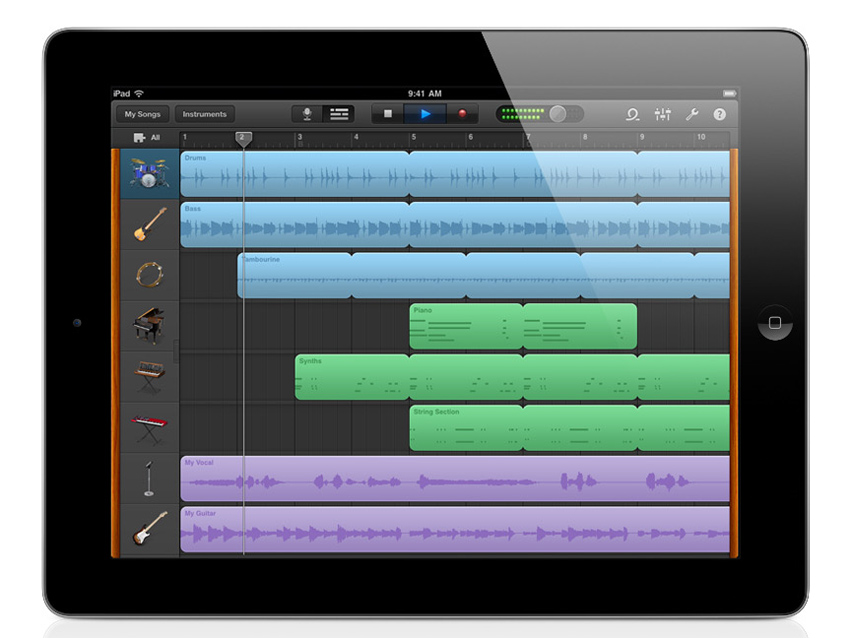GarageBand for iPad: 7 things musicians need to know

While bloggers often fall into the trap of overstating the importance and wider implications of new product releases by Apple, it's reasonable to suggest that the launch of GarageBand for iPad does have the potential to change the mobile music making landscape (you see, we've just done it).
Update: You can now read our hands-on review of GarageBand for iPad for a detailed overview.
With eight tracks of recording, guitar amps/stompboxes, 'smart' software instruments and compatibility with the desktop version of GarageBand, this $5 'mini DAW' could be the app that convinces you to take the plunge and buy an iPad.
With this in mind, let's take a step back to consider the software's release and what it means.
1. GarageBand will work on all iPads
The initial rumour was that GarageBand is an iPad 2 exclusive, but it now seems that it'll run on the original model too. However, we're guessing that this will be a pretty processor-intensive app (the desktop version is surprisingly CPU-hungry), so if you want to get the most out of it, you'll need an iPad 2. Which means…
2. The old iPad isn't much of a bargain
If you've been on the Apple Store in the last few hours you'll have noticed that the prices of the original have dropped considerably. So is now a good time to buy one? We'd say no: Apple is claiming that the iPad 2 is twice as fast as its predecessor, and you'll need that power if you want to run GarageBand (and, in all likelihood, many forthcoming iPad apps) effectively.
3. You can work on iPad GarageBand projects in Logic
One of the big disadvantages of many iOS apps is that, though they're great when considered in isolation, they're not compatible with your favourite desktop music making software.
Want all the hottest music and gear news, reviews, deals, features and more, direct to your inbox? Sign up here.
GarageBand for iPad is different: projects you create in this app can be loaded into the Mac version of the software, so it stands to reason that they'll also be compatible with Logic (Logic can open Mac GarageBand files, after all). This being the case, it'll almost certainly be a genuinely useful musical scratchpad, and might even help to drive Mac sales as users see what they can do on their iPad and get the urge to take their songs further. That said…
4. You might buy an iPad 2 instead of a laptop
If you've already got a powerful desktop computer but have been thinking of buying a laptop for simple, on-the-go music making, GarageBand for iPad might be the software to convince you that Apple's tablet will do instead. OK, it's not as powerful or flexible as a MacBook, but if it does everything you need, who cares?
5. GarageBand for iPad might hinder rather than help iPad music making software development
This sounds like a strange argument, but consider that GarageBand for iPad is going to cost $5, and if it works as promised, you're going to be getting an awful lot for your money.
So how are other iOS music making app developers going to compete? Those who are making non-traditional and/or performance-based products probably won't be concerned, but for any developer who's been thinking (or is in the process of) developing a DAW-style app, the performance bar may have just been raised considerably while the price ceiling has simultaneously been lowered.
That's going to be a difficult pill to swallow, so rather than kick-starting a new wave of iPad music making 'studio' releases, there's a real possibility that GarageBand for iPad could slow things down and make other developers wonder whether there's any point in trying to compete.
6. We don't yet know about MIDI and audio compatibility
Will you be able to plug a MIDI keyboard, audio interface or USB mic into your iPad via the Camera Connection Kit and have it instantly work in GarageBand? We honestly don't know yet, though we suspect that it may be possible (in some if not all cases).
It seems less likely, though, that GarageBand will be compatible with Line 6's MIDI Mobilizer, but we'll just have to wait and see.
7. The gauntlet's been thrown down to Android
There are some music making apps on Android, but nowhere near as many as on iOS, and nothing to compete with GarageBand for iPad. However, there are many new Android tablets coming to market at the moment, some of which are more than powerful enough to compete.
The challenge for developers is turn Android and the hardware devices that run it into a stable, low-latency music making platform. And they need to do it soon, or Apple's vice-like grip on the mobile music making market may never be loosened.
Liked this? Now read: The best iPad music making apps in the world today
Connect with MusicRadar: via Twitter, Facebook and YouTube
Get MusicRadar straight to your inbox: Sign up for the free weekly newsletter

I’m the Deputy Editor of MusicRadar, having worked on the site since its launch in 2007. I previously spent eight years working on our sister magazine, Computer Music. I’ve been playing the piano, gigging in bands and failing to finish tracks at home for more than 30 years, 24 of which I’ve also spent writing about music and the ever-changing technology used to make it.